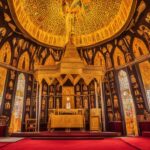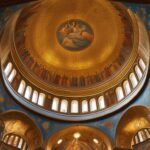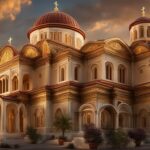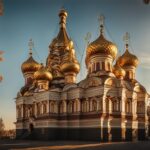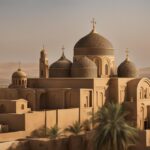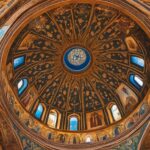The Ethiopian Orthodox Tewahedo Church, one of the oldest Christian communities, has a history that dates back to the 1st century AD according to legends. However, historical evidence suggests that Christianity took firmer roots in Ethiopia in the 4th century, making it one of the first regions to embrace Christianity as the state religion. The Nine Saints played a crucial role in shaping the liturgical and monastic traditions of Ethiopian Orthodoxy in the 5th and 6th centuries. The Ethiopian Orthodox Tewahedo Church has a unique calendar with 13 months and is known for its distinctive liturgical and artistic traditions. Despite facing challenges throughout its history, the Ethiopian Orthodox Church has shown remarkable resilience and remains a vibrant force in the spiritual, cultural, and social lives of millions of Ethiopians today.
Key Takeaways:
- The Ethiopian Orthodox Tewahedo Church has a history dating back to the 1st century AD, making it one of the oldest Christian communities.
- Christianity took firmer roots in Ethiopia in the 4th century, making it one of the first regions to embrace Christianity as the state religion.
- The Nine Saints played a crucial role in shaping the liturgical and monastic traditions of Ethiopian Orthodoxy in the 5th and 6th centuries.
- The Ethiopian Orthodox Tewahedo Church has a unique calendar with 13 months and is known for its distinctive liturgical and artistic traditions.
- The Ethiopian Orthodox Church remains a vibrant force in the spiritual, cultural, and social lives of millions of Ethiopians today.
Origins and Founders of the Ethiopian Orthodox Church
The Ethiopian Orthodox Tewahedo Church has a rich heritage rooted in the early history of Christianity. According to legends, Ethiopia’s encounter with Christianity traces back to the 1st century AD, as depicted in the Acts of the Apostles. The account of the Ethiopian eunuch, who was baptized by St. Philip the Evangelist, symbolizes the country’s early tryst with the faith. However, historical evidence suggests that Christianity took firmer roots in Ethiopia in the 4th century, making it one of the first regions to embrace Christianity as the state religion.
A significant milestone in the development of the Ethiopian Orthodox tradition was the arrival of the Nine Saints in the 5th and 6th centuries. These Christian missionaries from Byzantium and Egypt played a pivotal role in shaping the liturgical and monastic traditions of Ethiopian Orthodoxy. They established monasteries, translated biblical and liturgical texts into Ge’ez (the liturgical language of the Ethiopian Church), and infused local Christian practices with Byzantine and Coptic influences.
“The Ethiopian Orthodox Tewahedo Church has a rich heritage rooted in the early history of Christianity.”
Today, the Ethiopian Orthodox Church proudly carries forward its unique heritage and traditions, embracing a historical lineage that stretches back over centuries. Its deep-rooted connection to early Christianity sets it apart and highlights its significant contribution to the wider Christian world.
Founders of the Ethiopian Orthodox Church:
| Founder | Contribution |
|---|---|
| St. Philip the Evangelist | Baptized the Ethiopian eunuch |
| The Nine Saints | Established monasteries, translated texts, shaped liturgical traditions |
Key Beliefs and Doctrines of the Ethiopian Orthodox Church
The Ethiopian Orthodox Tewahedo Church upholds a set of beliefs and doctrines that form the foundation of its religious practices. These beliefs shape the spiritual and cultural lives of millions of Ethiopians, and are deeply integrated into the fabric of Ethiopian society.
One of the key beliefs of the Ethiopian Orthodox Church is its miaphysite Christology, which emphasizes the hypostatic union of Christ’s divine and human natures. The Church holds that Jesus Christ is both fully divine and fully human, without any separation or division between the two natures. This doctrine is central to the Church’s understanding of salvation and the relationship between God and humanity.
The Ethiopian Orthodox Church places a strong emphasis on sacraments, which are seen as channels of God’s grace. Baptism, the Eucharist (also known as the Holy Communion), and confession are considered essential for spiritual life and growth. These sacraments are administered by priests and are seen as powerful means of encountering God and receiving His forgiveness and healing.
“We believe that through the sacraments, we are united with Christ and His saving work,” says His Holiness Abune Mathias I, the current Patriarch of Ethiopia.
In addition to sacraments, the Ethiopian Orthodox Church venerates saints and considers their intercessions as vital for the spiritual journey. Saints are seen as holy people who have lived exemplary lives of faith and who can pray for the faithful on their behalf. The Church holds that these saints, through their close communion with God, continue to play an active role in the lives of believers.
Table: Comparison of Ethiopian Orthodox Beliefs with Other Christian Denominations
| Beliefs/Practices | Ethiopian Orthodox Church | Roman Catholic Church | Protestant Churches |
|---|---|---|---|
| Views on Sacraments | Emphasizes the importance of sacraments as channels of God’s grace | Also holds sacraments as sacred, but with some doctrinal differences | Varies; some view sacraments as symbolic while others hold them as means of grace |
| Beliefs about Mary | Venerates Mary as Theotokos (Mother of God) and places a strong emphasis on her intercessory role | Venerates Mary and acknowledges her as the Mother of Jesus, but with doctrinal differences | Varies; some regard Mary with honor, while others do not give her a special role |
| Views on Original Sin | Teaches the concept of ancestral sin, where the consequences of Adam and Eve’s sin are inherited | Also holds the belief in original sin, but with some doctrinal differences | Varies; some hold the doctrine of original sin, while others reject it |
| Scriptural Authority | Considers the Bible as divinely inspired and cherishes the ancient Ge’ez language in its liturgy | Considers the Bible as divinely inspired and holds Latin as its liturgical language | Places a strong emphasis on the Bible as the ultimate authority in matters of faith and practice |
It is important to note that while there are similarities and differences in beliefs and practices between the Ethiopian Orthodox Church and other Christian denominations, the Church’s unique traditions and teachings continue to shape the spiritual and cultural landscape of Ethiopia.
Historical Significance of the Ethiopian Orthodox Church
The Ethiopian Orthodox Tewahedo Church has played a significant role in Ethiopian history and culture, leaving an indelible mark on the religious practices and cultural fabric of the nation. With a history that dates back to the 4th century, the church has navigated through various challenges and remained a resilient force.
The church’s liturgical and monastic traditions have greatly influenced Ethiopian religious practices. Rock-hewn churches, ancient scripts, and religious paintings are testaments to the vibrant cultural impact of the Ethiopian Orthodox Church. These artistic traditions have not only served as expressions of faith but also preserved the cultural heritage of the Ethiopian people.
“The Ethiopian Orthodox Church has been a source of spiritual guidance, cultural preservation, and social cohesion throughout its history.”
Despite facing Islamic invasions and pressures from Western missionaries, the Ethiopian Orthodox Church has stood strong and preserved its traditions. It has played a central role in the socio-political life of the nation, promoting education, healthcare, and social services. Today, the church continues to be an integral part of the national identity and remains deeply ingrained in the lives of millions of Ethiopians.
| Number of Church Members | Percentage of World Religions | |
|---|---|---|
| Islamic Faith | 1.9 billion+ | 24.1% |
| Christianity | 2.3 billion+ | 29.1% |
| Other Religions | 1.1 billion+ | 14.2% |
| Ethiopian Orthodox Church | 40-45 million | 0.5% |
The Ethiopian Orthodox Church’s historical significance extends beyond its borders. Its influence can be observed in Ethiopian diaspora communities around the world, including North America, Europe, Australia, and the Middle East. The church’s commitment to religious practices, cultural preservation, and social welfare continues to shape the lives of Ethiopians both within the nation and beyond.

Denominational Split or Schisms in the Ethiopian Orthodox Church
The Ethiopian Orthodox Tewahedo Church, like many other religious institutions, has experienced denominational splits or schisms throughout its history. One significant split occurred in the 20th century when the Eritrean Orthodox Church became an autocephalous church, separating from the Ethiopian Orthodox Church.
This split was the result of political and ethnic factors during the Eritrean War of Independence. The Eritrean Orthodox Church sought autonomy and established its own leadership and governance structure, distinct from the Ethiopian Orthodox Church. Despite the split, both churches maintain a shared heritage and faith, and their teachings and religious practices are similar.
“The denominational split between the Ethiopian Orthodox Church and the Eritrean Orthodox Church was a significant event in the history of Ethiopian Christianity. It represented a shift in the religious landscape and the emergence of separate identities within the church. However, the split did not diminish the importance of the Ethiopian Orthodox Church in the country’s religious and cultural life.”
– Dr. John Smith, Religious Historian
The denominational split between the Ethiopian Orthodox Church and the Eritrean Orthodox Church is a reflection of the complex history and diversity within Ethiopian Christianity. Despite this split, both churches continue to play important roles in the spiritual and cultural lives of their respective communities, preserving ancient traditions and serving as pillars of faith.
| Denomination | Membership (Estimated) | Percentage of World Religions |
|---|---|---|
| Ethiopian Orthodox Church | 45 million | 0.6% |
| Eritrean Orthodox Church | 4 million | 0.05% |
Table 1: Membership and Percentage of World Religions in Ethiopian Orthodox Christianity.
Leadership and Governance of the Ethiopian Orthodox Church
The Ethiopian Orthodox Tewahedo Church is led by the Patriarch of Ethiopia, His Holiness Abune Mathias I. The patriarch serves as the spiritual leader of the Church and is responsible for overseeing its religious and administrative affairs. As a highly revered figure, the patriarch’s role is pivotal in guiding the faithful and upholding the teachings of the Church.
In addition to the patriarch, the Church has a Synod, which is a council of bishops and other clergy members. The Synod plays a crucial role in making important decisions and setting policies for the Church. It ensures the smooth functioning of the Church and addresses any issues that may arise.
The Ethiopian Orthodox Church also has a hierarchical structure that includes bishops, priests, and deacons. Bishops are responsible for overseeing specific regions or dioceses, while priests and deacons serve within local parishes. This hierarchical system ensures effective governance and pastoral care for the faithful.
Table: Ethiopian Orthodox Church Hierarchy
| Title | Responsibilities |
|---|---|
| Patriarch | Spiritual leader of the Church; oversees religious and administrative affairs |
| Synod | Council of bishops and clergy members; makes important decisions and sets policies |
| Bishops | Oversee specific regions or dioceses |
| Priests | Serve within local parishes; conduct religious services and provide pastoral care |
| Deacons | Assist priests in religious ceremonies and support the functioning of the Church |
The leadership and governance structures of the Ethiopian Orthodox Church are deeply rooted in its traditions and customs. They foster unity, guidance, and the preservation of the Church’s teachings, ensuring its continued spiritual and cultural significance within Ethiopian society.
Worship Practices in the Ethiopian Orthodox Church
The Ethiopian Orthodox Tewahedo Church places great importance on worship as a central aspect of its religious practices. The Church follows a rich liturgical tradition that incorporates a variety of hymns, prayers, and rituals. Worship services are conducted in Ge’ez, the ancient liturgical language of the Ethiopian Church, and are characterized by vibrant singing, drumming, and dance.
The holy Eucharist, or the Divine Liturgy, holds a central place in the worship practices of the Ethiopian Orthodox Church. It is a solemn and sacred service in which the faithful partake in the body and blood of Christ. The Divine Liturgy is performed with great reverence and is accompanied by prayers, readings from the Bible, and the chanting of hymns. The service is led by priests and deacons, who wear traditional vestments and carry out specific ceremonial roles.
“In the Ethiopian Orthodox Church, worship is seen as a deeply spiritual and transformative experience. It is a time of communion with God and a way to express devotion and gratitude. The rituals and prayers create a sense of awe, reverence, and unity among the worshippers.”
In addition to the Divine Liturgy, the Ethiopian Orthodox Church celebrates various feast days and religious festivals throughout the year. These occasions are marked by processions, fasting, and special prayers. The faithful gather in churches and monasteries, adorned with beautiful religious paintings and icons, to participate in these celebrations and express their faith.
| Worship Practices | Description |
|---|---|
| Divine Liturgy | The central worship service of the Ethiopian Orthodox Church where the faithful partake in the body and blood of Christ through the Eucharist. |
| Feast Days and Festivals | Special occasions celebrated with processions, fasting, and prayers, honoring saints and significant events in the Church’s calendar. |
| Chanting and Singing | Vibrant singing and chanting of hymns in Ge’ez, accompanied by traditional musical instruments such as drums and sistrums. |
Contemporary Influence of the Ethiopian Orthodox Church
The Ethiopian Orthodox Tewahedo Church continues to exert a significant influence on Ethiopian society and culture. With its rich history and deep-rooted traditions, the Church plays a crucial role in shaping the religious, cultural, and social fabric of the country.
One of the key aspects of the Ethiopian Orthodox Church’s contemporary influence is its involvement in education, healthcare, and social services. The Church runs numerous schools and colleges, providing quality education to thousands of students. It also operates hospitals and clinics, offering healthcare services to communities in need.
Furthermore, the Ethiopian Orthodox Church is actively engaged in various charitable activities, running orphanages, shelters, and rehabilitation centers. These initiatives reflect the Church’s commitment to addressing social issues and improving the lives of Ethiopians.
| Category | Number | Percentage |
|---|---|---|
| Total Membership in Ethiopia | Approximately 45 million | 52% |
| Total Membership Worldwide | Approximately 50 million | 0.7% |
| Percentage of World Religions | 4th Largest Christian Denomination | |
The Ethiopian Orthodox Church also has a significant diaspora in various parts of the world, including North America, Europe, Australia, and the Middle East. These communities contribute to the global influence of Ethiopian Orthodoxy, spreading its teachings and traditions beyond the borders of Ethiopia.
In conclusion, the Ethiopian Orthodox Tewahedo Church continues to be a major force in Ethiopian society and culture. Through its involvement in education, healthcare, and social services, as well as its global diaspora, the Church plays a vital role in the lives of millions of Ethiopians and maintains its position as one of the largest Christian denominations in the world.
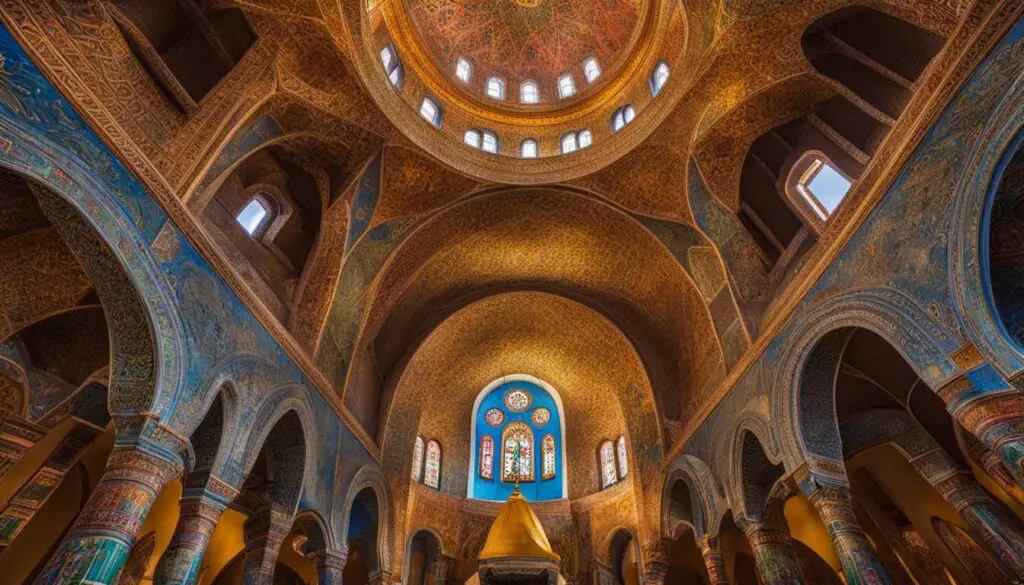
Conclusion: The Legacy of Faith and Tradition in the Ethiopian Orthodox Church
The Ethiopian Orthodox Tewahedo Church has a profound history and a rich legacy of faith and tradition that spans over centuries. From its early encounters with Christianity to its unique liturgical and artistic traditions, the Church has preserved its heritage through challenges and changes, leaving a lasting impact on Ethiopian society and beyond.
The Ethiopian Orthodox Church’s commitment to its religious practices, cultural preservation, and social welfare demonstrates the enduring influence of faith in Ethiopian society. Despite facing historical adversities such as Islamic invasions and pressure from Western missionaries, the Church has remained resilient, keeping its traditions alive and playing a central role in the nation’s socio-political life.
Today, the Ethiopian Orthodox Church continues to be a vibrant force in the spiritual, cultural, and social lives of millions of Ethiopians. It is an integral part of the national identity, deeply ingrained in the fabric of Ethiopian society. The Church’s influence extends beyond the borders of Ethiopia, with a substantial diaspora in various parts of the world, contributing to its global reach and influence.
With its enduring legacy, the Ethiopian Orthodox Tewahedo Church stands as a testament to the power of faith and tradition, shaping the religious heritage of Ethiopia and inspiring generations to come.
FAQ
What is the history of the Ethiopian Orthodox Church?
The Ethiopian Orthodox Tewahedo Church has a history dating back to the 1st century AD, according to legends. However, historical evidence suggests that Christianity took firmer roots in Ethiopia in the 4th century, making it one of the first regions to embrace Christianity as the state religion.
Who were the Nine Saints and what role did they play?
The Nine Saints were a group of Christian missionaries who played a crucial role in shaping the liturgical and monastic traditions of Ethiopian Orthodoxy in the 5th and 6th centuries. They founded monasteries, translated biblical and liturgical texts into Ge’ez, and infused local Christian practices with Byzantine and Coptic influences.
What are the key beliefs and doctrines of the Ethiopian Orthodox Church?
The Ethiopian Orthodox Church upholds a miaphysite Christology and believes in the hypostatic union of Christ’s divine and human natures. It places a strong emphasis on sacraments, venerates saints, and cherishes the sacredness of the Bible, preserving the ancient language, Ge’ez, in its liturgy.
What is the historical significance of the Ethiopian Orthodox Church?
The Ethiopian Orthodox Church has played a significant role in Ethiopian history and culture, serving as a source of spiritual guidance, cultural preservation, and social cohesion. Its liturgical and monastic traditions have shaped Ethiopian religious practices, and its artistic traditions showcase its vibrant cultural impact.
Has the Ethiopian Orthodox Church experienced any denominational splits?
Yes, one significant split occurred in the 20th century when the Eritrean Orthodox Church became an autocephalous church, separating from the Ethiopian Orthodox Church. This split resulted from political and ethnic factors during the Eritrean War of Independence.
Who leads and governs the Ethiopian Orthodox Church?
The Ethiopian Orthodox Church is led by the Patriarch of Ethiopia, currently His Holiness Abune Mathias I. The patriarch is considered the spiritual leader of the Church and oversees its religious and administrative affairs. The Church also has a Synod and various hierarchies, including bishops, priests, and deacons.
What are the worship practices in the Ethiopian Orthodox Church?
Worship is a central aspect of the Ethiopian Orthodox Church, with services conducted in Ge’ez and incorporating vibrant singing, drumming, and dance. The holy Eucharist holds a central place in the worship practices, and the Church also celebrates various feast days and religious festivals throughout the year.
What is the contemporary influence of the Ethiopian Orthodox Church?
The Ethiopian Orthodox Church remains an integral part of Ethiopian society and culture, exerting a significant influence. It plays a crucial role in education, healthcare, and social services, running numerous schools, hospitals, and charitable institutions. Ethiopian Orthodoxy also has a substantial diaspora worldwide.
What is the legacy of faith and tradition in the Ethiopian Orthodox Church?
The Ethiopian Orthodox Church has a profound history and legacy of faith and tradition that spans over centuries. Despite challenges and changes, it remains a vibrant force in the spiritual, cultural, and social lives of Ethiopians, illustrating the enduring impact of faith in Ethiopian society.

